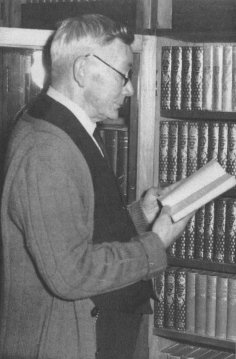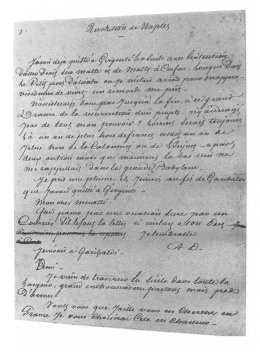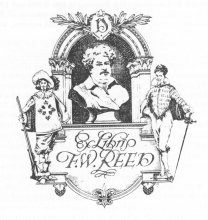
| Le site web Alexandre Dumas père | The Alexandre Dumas père Web Site | |||
 |
||||
| Dumas|Oeuvres|Gens|Galerie|Liens | Dumas|Works|People|Gallery|Links | |||

|
| Frank W. Reed 1874-1953 |
This book was an absolute revelation to me - an awakening which I fondly compare with Alexandre Dumas' own first acquaintance with Shakespeare upon the stage. Here at last was history in fiction, written as it should be presented, swift, full of action, with brilliant, clever, natural and sweeping dialogue, and also, though I could probably not then have divined it, an impassioned delineation of human nature.3Reed was so captivated by Dumas' ability to present 'history in fiction' that he asked his friend to purchase another. The next purchase was Dumas' The Count of Monte Cristo.
One day in the summer, on the lawn at our house, I read aloud some part of King Arthur to my grandmother Wild, who was visiting us. It was a very childish affair, but after a while she suggested that it was not a particularly good book - which is perhaps why it was so attractive; good books do not always appeal to children. Then she went on to say if I would give it up, she would give me a better one instead. I did not wish to do this, very greatly in fact did I wish to retain my own. Still, at the age of eight grandmothers exert a strong influence. Instead of it I was given A Life of David Livingstone, which I never read. The effect however was much more than that; it completely put me off all interest in missionary reading and banished any interest I might have felt for Africa.7There were also some frustrations:
On one occasion I was deeply absorbed in a Scotch tale of some baronial period, and had just reached the place where the hero had climbed up the ivy on a castle wall to rescue his lady love, the baron's daughter. As he was preparing to escape with her, into the room burst her brother. Swords were drawn, and a fine combat ensued, the lady shrinking into a corner. The brother was getting the worst of it, and was driven back to the wall; but there he pressed some hidden spring, and a large section of the flooring gave way, carrying with it the hero into the oubliettes below. Then followed the ominous words: 'To be continued in our next.' ... Swiftly I turned over the small heap of magazines; nowhere could I find the next. Downstairs I went, three at a time and burst into the kitchen. 'Grandmama, where is the next number to this?' - 'Let me see it. Ah! yes, your uncle thought the stories less interesting than before, and he stopped taking the magazine.8Such a scenario, serialized, and with all the elements of action, adventure and romance, could tantalize a young reader. It did so with Reed, because sixty years on, he still had in his mind 'the question of what happened next and how the escape - which would certainly be accomplished - was managed.'9

|
|
Manuscript of Dumas' Les Garibaldiens: Révolution de Sicile et de Naples. Vol. 2, p. 1. |
I rather follow my own fancy in translating - not having had expert teaching. I endeavour to keep as near to my original as will give - I hope - good English reading. I never change a word from the French into a more distant English one unless there is cause. Nor do I change the form of my sentence arrangement from that of the original more than requisite. Personally I like a translation, not a paraphrase. I think it much more fair to your original, and kinder to your reader. Many who work in this way merely paraphrase, and often what I consider somewhat lazily. They seem to read a sentence or two, and then give the sense of what has been read. The danger is that it is so easy thus to lose the individuality of the writer and substitute your own. I don't like that. Many better versed that I would doubtless condemn my method, but it is at least honest if more humdrum.52Reed's translations exceed 20,000 typescript pages and include plays, poems, miscellaneous pieces, travel works, and romances by and about Alexandre Dumas. All of these items are housed in the Reed-Dumas Collection in the George Grey Rare Books Room Collection at the Auckland City Library. In total they represent hours of dedicated and disciplined work by Reed. A demanding professional life, the responsibilities of supporting a household, including a wife who was a diabetic, two children, and his remoteness from the mainstream of Dumas studies, heighten his accomplishments. And it was this accomplishment in the field of translation that became an integral part in his bibliographical studies.
The compilation of an authoritative bibliography of so towering a figure in the world of international letters would have entailed a lifetime of close application with the great libraries of the Old World and America at hand. Mr. Reed has accomplished the extra miracle of achieving his memorable results in his watchtower at Whangarei, thousands of miles away from the centres where most of his information lay. Exact and exhaustive scholarship is difficult enough, in an isolated and remote country like New Zealand, in any branch of human culture. The obstacles in the path of research on such a theme are on the face of things insuperable. Now the fruit of so much toil, carried through with so much courage and delight, is given to the world.55Significantly, others too recognized his efforts. In 1927, Reed had been honoured by the French Government with the title of 'Officier d'Academie' for his services to literature. In 1934,just after the publication of his Bibliography, the French Government decorated him with the higher title of 'Palmes d'Officier de l'Instruction Publique', in token of appreciation and thanks for his services rendered for the diffusion of the French language and culture.
